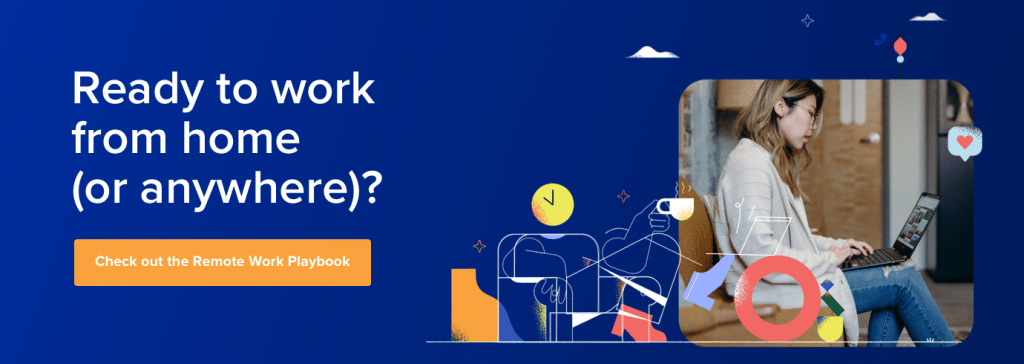For years, we’ve been hearing the same thing: “remote work is the future.” Yet even though there has been plenty of literature dedicated to highlighting the benefits to employee productivity, morale, and output, a lot of businesses have remained resistant to taking their workforce remote. Is this the year that finally changes?
The business world is at an inflection point regarding remote work. Cloud software is more widespread and affordable than ever. Commercial real estate costs, especially in urban centers, keep climbing. And for small business owners, the decision to embrace a remote workforce is no longer about offering it as an employee perk—it can be the difference between survival and death.
In this article, we’ll look at:
- The business benefits of remote work in numbers
- The lesser known benefits of remote work
- What your business can do now that the secret is out
With so much time already spent focused on discussing the many benefits of remote work, we wanted to highlight some of the lesser-known benefits. But just in case you’ve forgotten, here’s a high-level summary of some of the more oft-quoted facts:
The business benefits of remote work in numbers
- Remote employees work 1.4 extra days each month, translating to 3 extra weeks of work each year.1
- Gallup research found that optimal employee engagement occurs when employees spend between 60–80% of their time working remotely.2
- A two-year study from Stanford University found employees who work remotely are more productive—to the tune of one full day of work each week.3 So not only are remote employees working extra days, but they’re also adding additional time by being more productive.
So the impact to business well-being is well-documented. But what about the broader impacts? What about a world with less pollution, with happier people, and more equitable and communicative workplaces? What if this utopia can be achieved not through sweeping social reform, but simply by enabling your staff to work remotely? Read on to find out how.
The top secret(-ish) benefits of remote work
Environmental impact
Sun Microsystems had a lot of employees to study—35,000, to be exact, spread across 55 countries. When they started analyzing employee work patterns in their (extremely well-equipped) offices, they found a surprising result: most employees weren’t even using the infrastructure available to them.4
So they launched a small “open work” pilot project in two offices before deploying it to other countries. They enabled the program through a number of different channels: technology (giving staff the tools they need to work remotely), a network of places (like drop-in centers), and organizational infrastructure (like providing management with the skills required to effectively manage remote staff). Speaking of remote work tools, here’s a quick clip on what kind of tools to look for:
The open work program encompassed 24,000 employees—equivalent to a small city. And while the business benefits of remote work spoke for themselves, it was the environmental impact that was truly eye opening.
Through a combination of reduced carbon output from reduced on-site energy use, less solid waste disposal, and lastly, the erasure of 24,000 daily commutes, the company prevented the release of 32,000 metric tons of carbon dioxide into the air (for reference, the average person in the US emits 27 tons of CO2 each year.)
Xerox implemented a similar remote work program, and their employees drove 92 million fewer miles, enough to circle the globe 3,680 times.
And while we’re sure we’re all extremely altruistic and saving the planet is reason enough, the benefits of making a conscious improvement to the environment aren’t only enjoyed by Mother Nature. Millennials and Gen Z, the largest portions of today’s workforce, both feel strongly about the environment—millennials in particular are a purpose-driven generation.
Making a conscious decision to improve the environment and be a socially responsible workplace can yield incredible results, both for your hiring pipeline and for your sales.
Want more WFH tips? Download the Remote Work Task Checklist.
Employee happiness
Okay, this one comes up pretty often when discussing the benefits of remote work, but we’re including it here because it’s surprising how much employee happiness is impacted by being able to work remotely—and how that can translate to better business results. Behavioral science has yielded some fascinating results that have completely upended corporate culture over the past couple of decades.
Gone are the days of pallid office workers schlepping to their cubicles day in and day out simply to earn a steady paycheck. Today, business leaders know that the most valuable employees and top performers are passionate, engaged in their work, and… dare we say… happy?
Employee happiness can have a huge impact on a business’s bottom line. Not only are happy employees more productive, they can also give your business a bump in sales—maybe even stock prices. Happy employees turn in a higher quality of work, with fewer errors, and are far less likely to quit for greener pastures, meaning businesses save by avoiding employee attrition as well.
When it comes to improving employee happiness, few efforts have made the impact that remote work policies have. In a 2019 report, Owl Labs found that full-time remote workers reported being happier in their jobs 22% more than employees who never worked remote.
There are a couple of factors at play, here. Number one, commuting is frequently the most frustrating part of any job—commuting can make employees as miserable as losing almost one-fifth of their salary. Removing the commute can go a long way towards improving employee happiness. Secondly, remote employees actually get more leisure time a year—up to 105 hours, even as they’re working additional time.
Harder working, more productive employees who are actually happier at the same time? Sounds like a business owner’s fantasy—but to make it reality, all you need to do is allow for remote work.
Having friends at work can multiply the happiness benefits employees experience—people who report having friends at work are more likely to report receiving recognition and praise, and believe that having friends are important to their overall happiness. Giving remote employees the tools to engage with their coworkers, wherever they are, is also important. Video conferencing tools can allow them to get valuable facetime, while instant messaging apps allow them to keep in touch on their schedules.
[ebook-download title=”Grab the Remote Work Playbook” link=”https://www.ringcentral.com/remote-work-playbook.html” cta-text=”Read it now” src=”/us/en/blog/wp-content/uploads/2020/06/remote-work-playbook-1.png”]
Equitability
When Dentons, the world’s largest law firm, had to go fully remote in response to the COVID-19 pandemic, 19,000 employees in 183 offices across 75 countries suddenly found themselves working from home. And yet even as economies began to reopen, Dentons insisted staff would continue working remotely until all staff were able to safely return to work.
Joe Andrew, Global Chairman of Dentons, offered this explanation: “Here is why: If your company decides to reopen and you can drive your nice car to the office but your assistant or your support team has to take public transportation, are you really going to force them to come into the office? If your support team is not there, is there any reason for you to be there? If you aren’t certain if you have to come in, then won’t your other coworkers ask the same question? If they don’t come into the office, and some are on video conferences rather than in-person meetings, then why not just have everyone on video?”
For example, why not use a video conferencing platform like to make it easy for everyone to get on video calls, no matter where in the world they are?
Remote work can be the great equalizer across global workforces, guaranteeing that every employee receives equal treatment. Regardless of race, sex, or economic status, remote work can offer every employee the same experience, the dignity of working safely at home, and a feeling of equity from knowing they are being treated exactly the same as everyone else.
That doesn’t always come naturally, however. In order to make sure that employees are being treated equitably, it helps if businesses are collecting and actioning on employee feedback, helping employees to feel heard. As we learned during the COVID-19 pandemic, each employee will have a unique set of circumstances that needs to be approached with empathy (for example, parents, pet owners, or people with uncomfortable home situations.)
Lastly, using communication tools to maintain open lines of two-way communication with employees can help business leaders understand employee needs, manage employee expectations, and get the opportunity to better connect with employees on a personal and professional level.
Stronger hiring pipeline
Fact: the average cost to hire a new employee is four to five thousand dollars. Fact: unhappy employees leave companies faster than happy ones. Fact: remote work can be both a preventative measure to stop employees from leaving, as well as a proactive measure to get more applicants coming in your door.
How? Well, we previously discussed the impact of remote work on employee happiness—and it’s widely known that happy and engaged employees are less likely to quit, helping your business to prevent costly employee attrition.
Those happy employees are also likely to refer others in their network to work with them—and referred employees have the highest applicant to hire conversion rate, dramatically reducing that cost to hire. Referred employees also onboard quicker, have greater job satisfaction, and stay longer at companies—creating a flywheel effect that can compound and allow you to grow your talent network even larger.
Not only that—when you’re dealing with remote or distributed teams, you gain access to a much broader talent pool from which to hire. This makes it easier for businesses to hire A-players, highly specialized roles, and even short-term skilled employees.
Lastly, remote working arrangements are still an extremely attractive hiring perk. Offering new hires the freedom and flexibility to work from anywhere, skip the commute, and build an integrated life around their job is something that resonates with today’s workforce. In fact, 54% of employees say they would change jobs for one that offered them more flexibility. And a shocking 98% of surveyed employees in the 2020 State of Remote Work Survey said they would like to work remotely, at least some of the time, for the rest of their career.
Hiring remotely can be a challenge for teams that aren’t equipped with the right remote work tools. From interviewing to managing, use tools that give you the chance to build a personal connection with employees and get a stronger understanding of who they are. For example, you might find employee engagement apps particularly helpful if you have a distributed team.
Disaster preparedness
If there’s anything we’ve learned from the COVID-19 crisis, it’s that disaster can strike at any time. Regardless of whether we’re discussing natural disasters, local internet outages, or a global pandemic, businesses must be prepared for a worst-case scenario to avoid days of business disruption, lost money, and potential business closure.
When managing a remote workforce, business continuity no longer depends on one singular location—it can be spread across cities, states, countries, or even globally. If disaster strikes one employee, the remainder of the business can go on functioning as usual.
For example, if staff are equipped to work remotely, such as in the case of insurance firm AmCap Insurance, they can easily transition to a new location and continue working when disaster strikes.
For AmCap, providing insurance relief to hurricane-prone prone-states like Florida, Louisiana, South Carolina, and Texas, disasters are a fact of life—particularly because they’re located in Florida themselves. But when natural disasters threaten their ability to deliver services to customers when they need them the most, AmCap is able to continue serving them in times of need, thanks to their adoption of cloud communication tools like RingCentral.
The average business disruption from a disaster is 18.5 hours, and the average cost in business losses is $148,200. By equipping staff to work remotely with the right tools, technology, and processes, businesses can head off those incredible losses and make sure they’re able to continue serving customers, turning a potential loss into a profit and the opportunity to build a brand of reliability.

The remote work benefits secret is out
Better productivity. Better environmental impact. More hours worked. Higher employee engagement and happiness. A way to simultaneously retain and attract better employees. And the ability to keep your business running, no matter what disaster might be headed your way.
It almost sounds too good to be true, but it’s a “future of work” that is now very much in reach thanks to cloud technology and a range of affordable and user-friendly communication and collaboration tools. If you haven’t already embraced remote work, it’s time to start considering it—the future is never that far away.
1 businessnewsdaily.com/15259-working-from-home-more-productive.html
2 gallup.com/workplace/283985/working-remotely-effective-gallup-research-says-yes.aspx
3 inc.com/scott-mautz/a-2-year-stanford-study-shows-astonishing-productivity-boost-of-working-from-home.html
4 smartcommute.ca/more-options/telework/sun-microsystems/
Originally published May 31, 2020, updated Jun 24, 2024






